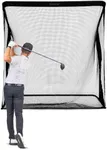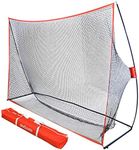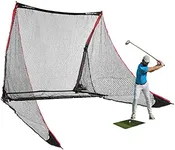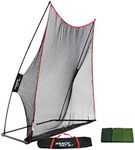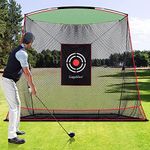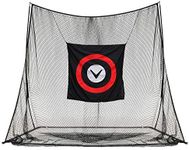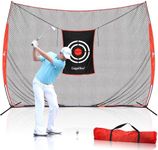Buying Guide for the Best Golf Practice Nets
Choosing the right golf practice net can make a big difference in how effectively you can practice your swing at home or in your backyard. The best net for you will depend on your available space, how often you plan to use it, and what kind of shots you want to practice. Understanding the key features will help you find a net that is safe, durable, and suitable for your needs.SizeThe size of a golf practice net refers to its width, height, and sometimes depth. This is important because it determines how much space you need to set it up and how much room you have to hit different types of shots. Smaller nets (around 6-7 feet wide) are good for limited spaces and basic chipping or short iron practice, while larger nets (8-10 feet wide or more) are better for full swings and drivers. To pick the right size, consider both the space you have available and the types of clubs you want to use. If you want to practice with all your clubs, including drivers, a larger net is safer and more versatile.
Net Material and DurabilityThe material of the net affects how well it can withstand repeated hits and how long it will last. Most nets are made from nylon or polyester, with thicker and more tightly woven nets being more durable. Some nets are designed to handle high-speed shots from drivers, while others are only suitable for lighter shots. If you plan to practice frequently or use powerful clubs, look for a net with reinforced or double-layered netting. For occasional or light use, a standard net may be enough.
Frame ConstructionThe frame holds the net in place and affects how stable and easy to set up the net is. Frames can be made from metal, fiberglass, or plastic. Metal frames are usually the most stable and durable, but they can be heavier. Fiberglass frames are lighter and easier to move but may not be as sturdy in windy conditions. If you want a net that stays in one place, a heavier frame is better. If you need to move or store it often, a lighter frame is more convenient.
Portability and SetupPortability refers to how easy it is to move and set up the net. Some nets are designed to be left in place, while others can be folded or collapsed for storage and transport. If you have a dedicated practice area, portability may not matter much. But if you need to set up and take down the net frequently, look for one that is lightweight, comes with a carrying bag, and has a simple assembly process.
Ball Return FeatureSome golf practice nets have a ball return system that rolls the ball back to you after each shot. This feature can save time and make practice more efficient, especially if you hit a lot of balls in one session. If you value convenience and want to maximize your practice time, a net with a ball return is a good choice. If you don’t mind collecting balls yourself, this feature may not be necessary.
Weather ResistanceIf you plan to use your net outdoors, weather resistance is important. This means the net and frame can withstand sun, rain, and wind without deteriorating quickly. Look for nets with UV-resistant netting and rust-resistant frames if you’ll leave it outside. If you only use it indoors or bring it inside after use, this is less of a concern.
